Investment Overview
Bittensor is a general incentive platform inspired by the Bitcoin network, based on subnet architecture and game theory. Bitcoin incentivizes miners to complete SHA256 computations and maintain network availability through token issuance. Bittensor incentivizes subnet miners to provide various resources, including AI inference, data storage, GPU computing power, bandwidth, and more, through token issuance.
Team: The three core members all have computer science backgrounds. Ala is more focused on academic research and AI algorithms, Jacob specializes in machine learning and blockchain architecture, and Garrett has experience in engineering implementation and product development, making for a strong technical entrepreneurial team overall.
Development Progress: The development has been maintaining a normal pace, with an increase in development frequency over the past three months.
Product: Innovative token economics, where only subnet teams can receive incentives by improving the quality of their projects, thereby increasing the price of subnet tokens. Under Bittensor's game theory mechanism, subnets compete to provide optimal resources, including quantitative model performance, GPU pricing, storage cost-effectiveness, and protein folding discovery speed.
Ecosystem Development: Currently, there are 80 subnet projects in the ecosystem, with a trend of accelerated growth. However, there are many duplicate and similar businesses.
Narrative: Bittensor has a strong narrative connection with AI, DePin, public chains, and more.
Risks:
Lack of infrastructure, insufficient marketing and community support, leading to high opacity.
High ecological redundancy, lack of independent external development teams, with one Labs potentially building up to five or six subnet projects. This can lead to Labs being unable to focus on a specific project, resulting in competition with independent external competitors.
The mechanism design of TAO is complex, involving multiple details, leading to high learning costs for retail investors and requiring a significant knowledge base from the project team.
Bittensor's ecosystem development shows an accelerating trend, with a unique architecture and currently no highly similar competitors emerging. Most AI products are competitors of subnet projects. We hold an optimistic attitude towards its ecosystem development. Unlike Allora and Sentiment, where miners can only provide large models and Sahara AI can only provide data, Bittensor's subnets (miners) operate more like multiple countries within a single world system. Bittensor rewards countries that develop well, and each country has complete freedom in the specific business it develops, as long as it does not exceed the worldview set by Bittensor. The evaluation standard is whether each country's currency is valuable. Under this more open and unique incentive structure where subnets have their own tokens, there is an opportunity to create a remarkable ecosystem. We have also seen venture capital firms, including YZi Labs, beginning to invest in the Bittensor ecosystem.
Basic Overview
1.1 Project Introduction
Bittensor is a general incentive platform inspired by the Bitcoin POW network, based on subnet architecture and game theory. Bitcoin incentivizes miners to complete SHA256 computations and maintain network availability through token issuance. Bittensor incentivizes subnet miners to provide various resources, including AI inference, data storage, GPU computing power, bandwidth, and more. Through game theory and token incentives, it builds a healthy competitive environment to provide distributed crowdsourced services.
1.2 Basic Information
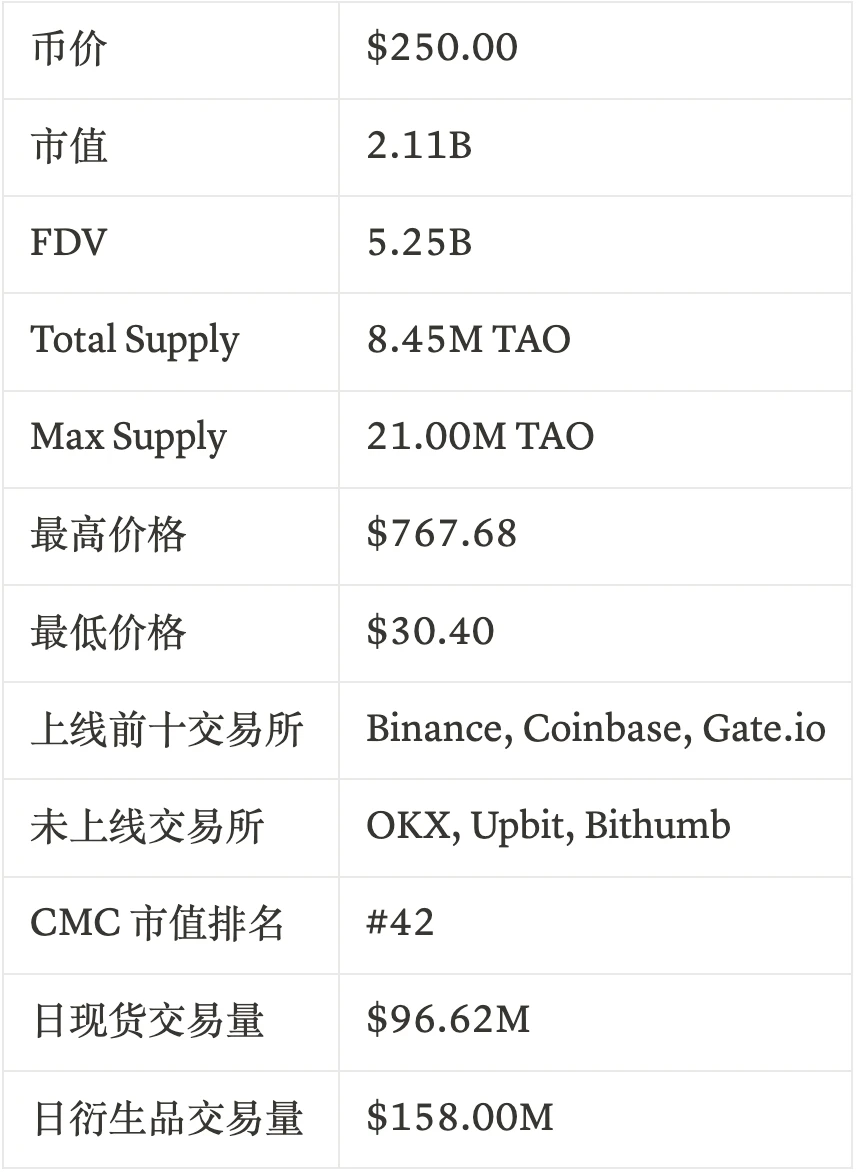
Note: Information sourced from CoinMarketcap & Coinglass, statistics date March 17, 2025.
2 Project Details
2.1 Team Background Check

Jacob Robert Steeves: Founder, graduated from Simon Fraser University with a Bachelor of Applied Science, majoring in Mathematics and Computer Science. During his time at school, he participated in the ACM-ICPC programming competition and achieved 8th place in the 2014 Northwest North America region. Jacob's career experience includes machine learning research (Knowm), algorithm development (Google), and exploration in decentralized technology (Bittensor). His work primarily revolves around machine learning, distributed computing, and cryptographic technology, along with experience in traditional tech companies.

Ala Shaabana: Co-Founder, graduated with a Bachelor's degree in Computer Science from the University of Windsor and a PhD from McMaster University. His career experience includes software development (firmCHANNEL, VMware, Instacart) and academic research at universities. His work spans computer science, machine learning, and distributed computing, with both corporate R&D experience and an academic research background.

Garrett Oetken: CTO, graduated from the University of Idaho with a major in Computer Science. His career experience includes software development (Safeguard Equipment), AI research, and technology entrepreneurship (Quantum Star Technologies, Opentensor Foundation). His work involves AI, computer vision, natural language processing, and distributed computing.
Opentensor is the development team behind Bittensor, founded in March 2023, with approximately 40 employees, a 3% decrease over the past six months, and an average tenure of 1.3 years. The three core members all have computer science backgrounds, with Ala focused on academic research and AI algorithms, Jacob specializing in machine learning and blockchain architecture, and Garrett having experience in engineering implementation and product development, making for a strong technical entrepreneurial team overall.
2.2 Funding/Financing Situation
Bittensor has never publicly disclosed its financing situation in the primary market. Currently, publicly available information includes several million dollars in OTC token transactions from Polychain, DCG, and DAO5.
2.3 Code

Contributors, source: Github
Opentensor's main repository Tensor has shown good development progress, with a noticeable acceleration in codebase updates in the first quarter of 2025.
2.4 Product
2.4.1 Background
The product concept of Bittensor originated from the interpretation of the Bitcoin network. From Bittensor's perspective, the Bitcoin network incentivizes global miners to run algorithms to maintain the overall network's availability through token economics. However, the computational resources contributed by the Bitcoin network are very basic and singular. Inspired by this, Bittensor incentivizes miners to provide a broader range of digital resources or intelligent computing resources in the AI era. In the Bitcoin network, all miners run the same algorithm SHA256, but in Bittensor, miners can run different algorithms or provide different resources (AI inference, data storage, computing power, bandwidth, etc.), which can further be abstracted into a decentralized market, rewarded by Bittensor's unified incentive mechanism.
2.4.2 Product Introduction
Bittensor is an open-source platform where participants can produce digital goods, including computing power, storage space, AI inference and training, protein folding, financial market predictions, and more. Bittensor consists of different subnets. Each subnet is an independent community of miners (producers of goods) and validators (assessing the work of miners). Subnet creators are responsible for managing the incentive mechanism, and TAO stakers can support specific validators by staking TAO.
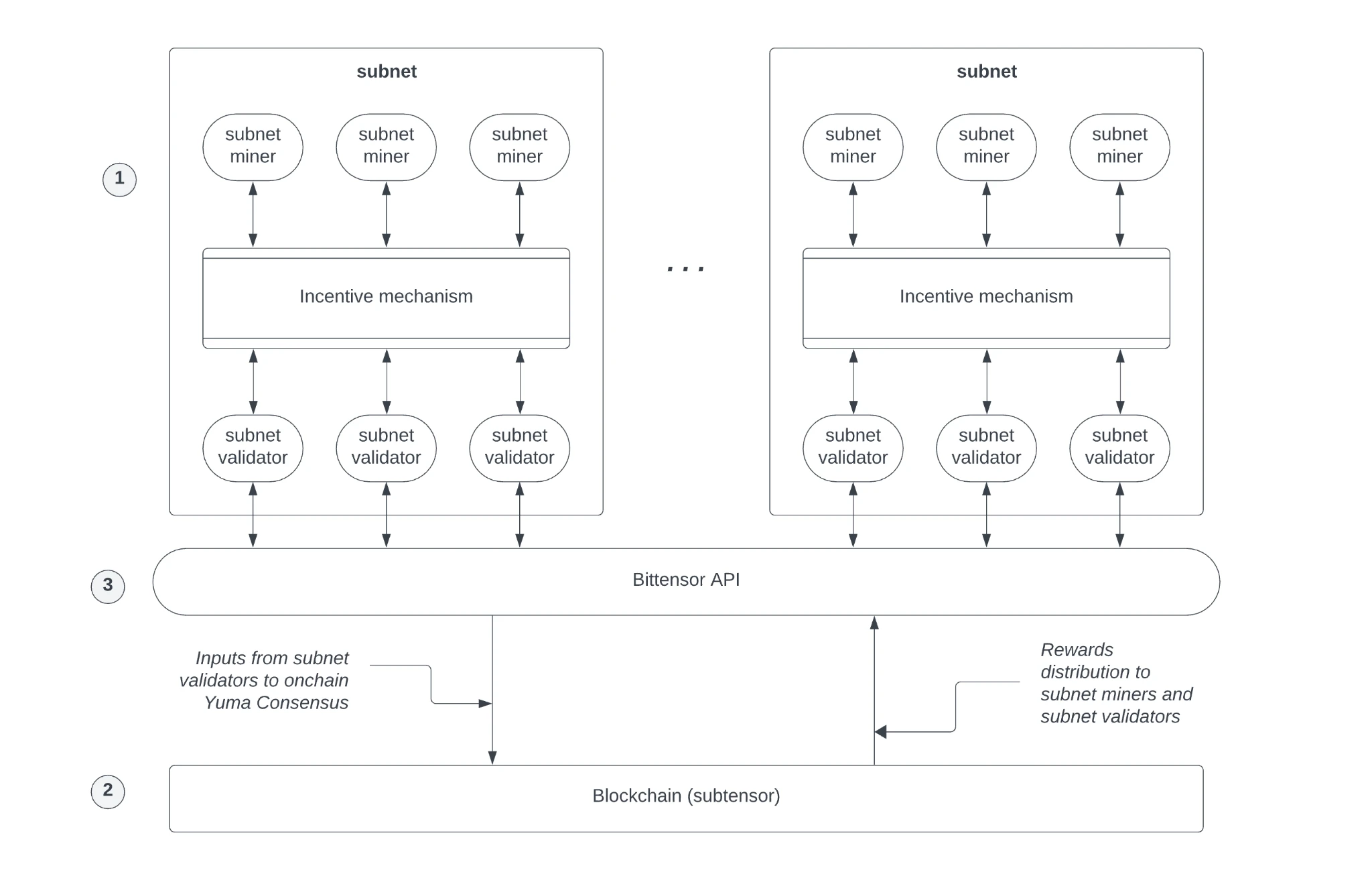
The architecture of TAO, image source: Bittensor
TAO consists of several components as shown in the image above:
Subnet. Each subnet is a competitive market based on incentives, producing a specific digital good related to artificial intelligence. It consists of a community of miners producing goods and validators measuring the work of miners according to specific subnet standards to ensure quality.
The Bittensor mainnet acts as a recording system, with its token TAO serving as an incentive for participating in subnet activities. The Bittensor blockchain records the balances and transactions of miners, validators, and subnet creators.
Bittensor API, which supports interactions between miners and validators within subnets and allows parties to interact with the blockchain as needed.
Each subnet has two roles: miners and validators.
Miners
● In Bittensor's concept, "miners" are not just running computing power to mine PoW, but can provide training or inference resources for AI models (or other digital goods, such as data bandwidth, etc.).
● Different subnets may target different tasks (NLP, CV, multimodal, etc.), and miners can choose subnets that suit their hardware/algorithms to contribute resources and receive incentives.
Validators
● Validators still need to maintain the security of the Bittensor main chain, packaging blocks, validating transactions, etc. (referencing the Polkadot/Substrate mechanism) to keep the network running normally.
● There are also subnet-level validators who help verify whether the subnet adheres to consensus rules and prevent malicious behavior.
Subnet Liquidity
The key mechanism introduced by Bittensor is that each subnet has its own AMM mechanism. This AMM Pool has two token reserves, one containing the tokens of the TAO mainnet itself, and the other being the subnet's own token (which we collectively refer to as Alpha Token). The subnet token can only be purchased by staking TAO tokens into the subnet reserve. For example, suppose there are 1,000 TAO and 16,000 subnet Alpha tokens in the pool, then according to the formula:

This means that one Alpha token is worth 0.0625 TAO. When everyone is optimistic about the Alpha token, they will purchase Alpha using TAO, which reduces the supply of Alpha while increasing the amount of TAO, driving up the price of Alpha. It is worth noting that the network will also "inject" a portion of new TAO and new subnet tokens into the subnet with certain rules for each block, which will also affect the token prices.
However, how the subnet tokens are specifically issued and how TAO incentivizes the subnets is related to Bittensor's latest dynamic TAO mechanism, which we will introduce next.
2.4.3 Technical Details
In the past, Bittensor's key technology was its Yuma Consensus algorithm, which aimed to solve a problem—how to reach consensus on "AI model contributions" and distribute incentives in a decentralized network while resisting collusion and cheating among nodes. This algorithm is responsible not only for the consensus voting of validators but also for determining how much TAO incentive each subnet should receive. However:
Validators cannot comprehensively assess a large number of subnets, leading to inaccurate scoring, indifference, or bribery;
Subnets may privately "bribe" validators to inflate votes;
High-quality subnets deserving more incentives may be neglected in an unfair environment.
Therefore, Bittensor has built an improved mechanism to evaluate the contributions of subnets, known as dynamic TAO. The new idea of DTAO: to leave "which subnet should receive more token issuance" to the market, by issuing a subnet token (Alpha) for each subnet and combining it with the AMM pool, allowing market prices to judge the value of the subnet. If a subnet is more promising, the price of the subnet token will be higher, and the proportion of TAO obtained from each issuance will also be higher, while the issuance incentives for Alpha tokens will increase.
For example, suppose we have two subnets, Subnet A and Subnet B, each issuing one TAO per block.
When Subnet A and Subnet B go live, they have their subnet tokens, alphaA and alphaB, with prices Pa and Pb. If there are no special configurations, the ratio is generally 1:1 for TAO and subnet tokens, while the total amount of Alpha tokens is also capped at 21 million, just like TAO.
The total amount of TAO that each subnet can receive, Δτ, is proportional to its token price in the "total token price of the network." The formula is generally:

Therefore, if the prices Pa and Pb of the two subnets are both 1 TAO, then after each block issuance, the subnet can receive 0.5Δτ. If the market is more optimistic about alphaA, then the market will inject more TAO into the A subnet's AMM pool.
To maintain the price stability of the AMM pool, the subnet will also receive corresponding Alpha injections. The usual approach is:
First calculate Δαi—"how much Alpha needs to be injected to maintain the current price pi."
If the calculated value exceeds the subnet's Alpha issuance cap, the actual injection value is truncated (only injected up to the cap).
In the DTAO rules, in addition to the portion of Alpha injected into the pool, an equal amount of Alpha tokens will be directly distributed to subnet roles, replacing the previous method of issuing TAO.
● Miners occupy 41%
● Validators occupy 41%
● Subnet Owners occupy 18%
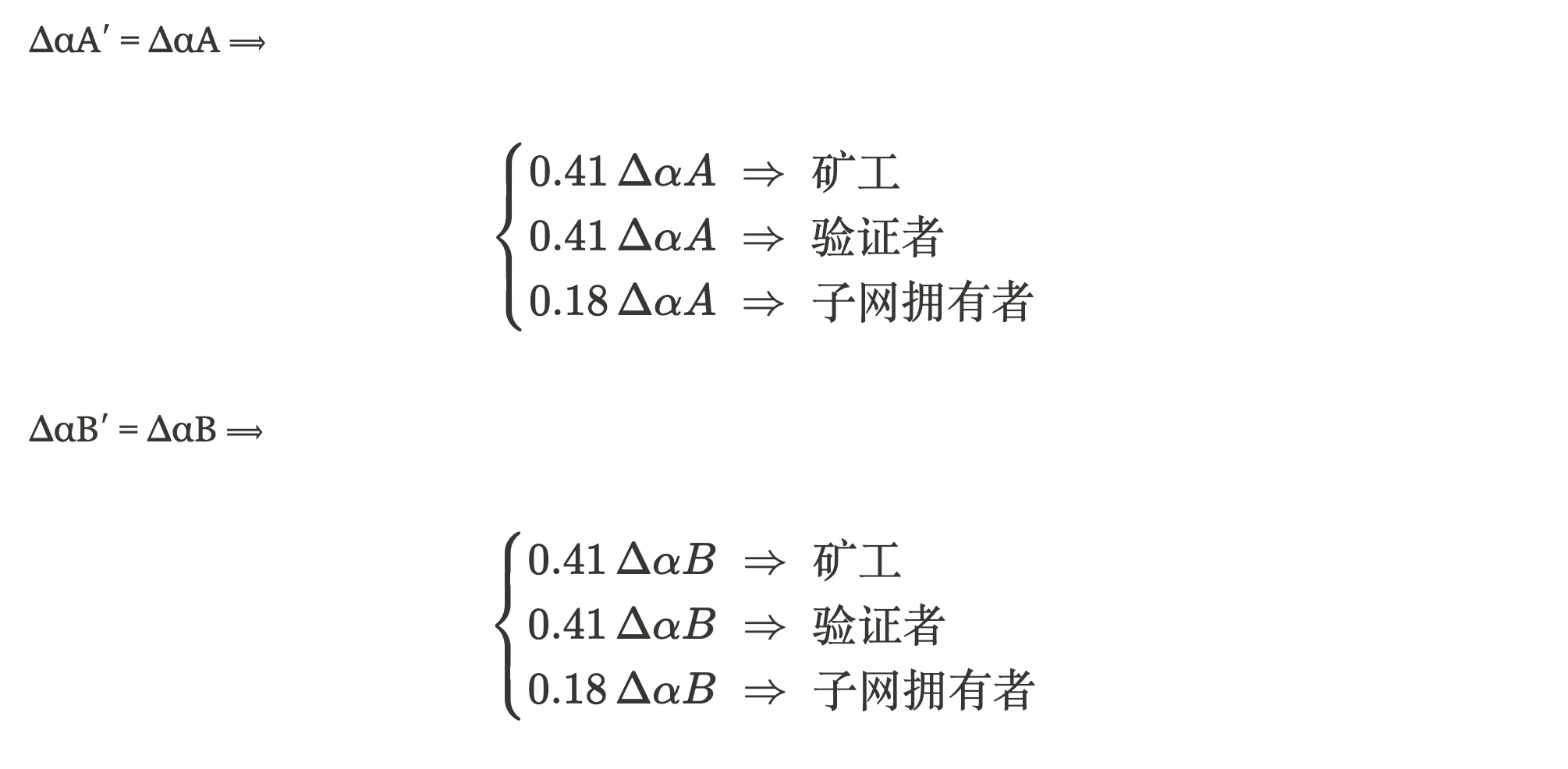
The injection into the pool is to maintain the price; distribution to nodes is to incentivize ecological roles. Alpha tokens are reserved and will be distributed in one lump sum after a Tempo period (360 blocks) to avoid overly fragmented reward distribution. Miners are responsible for providing computing power, storage, inference, and other functions for the subnet, and the only tokens they can earn are through this issuance mechanism, while validators are responsible for verification.
A common question arises: with each TAO injection, although Alpha tokens are proportionally issued into the AMM, this portion of the pool's price remains constant, but the additional issuance of corresponding tokens will lead to extra selling pressure. This is similar to the Bitcoin miner reward mechanism, where the proportional injection of TAO and Alpha tokens into the AMM pool is intended to deepen the market liquidity of the subnet tokens, reduce slippage, and make market pricing more accurate, giving token holders more confidence. The proportional issuance rewards of Alpha tokens are designed to reward high-quality miners and subnet developers. In fact, since the total token supply is capped at 21 million, the subnet tokens will not be issued infinitely but will asymptotically approach 21 million, similar to the Bitcoin miner and Bitcoin issuance mechanism.
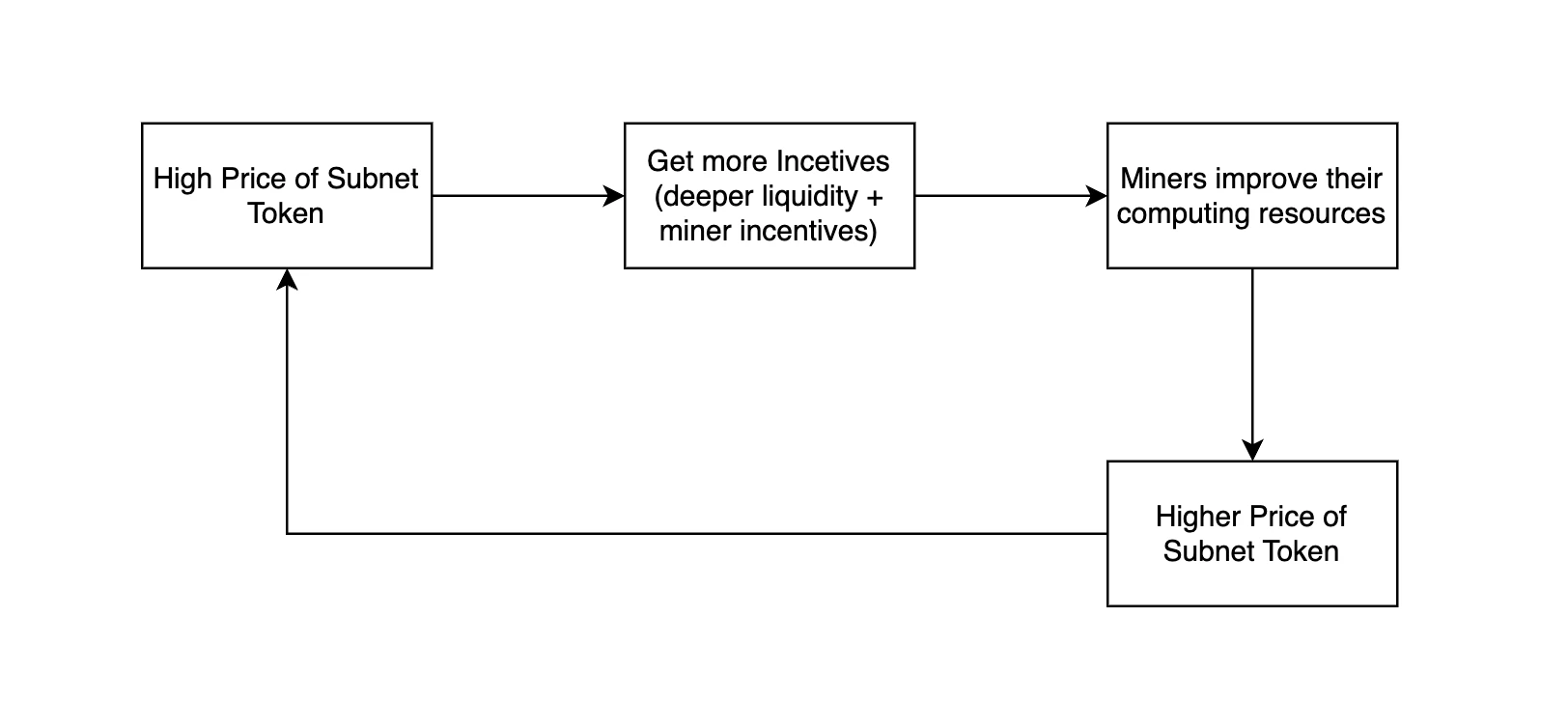
Positive Feedback Loop
In the new Dynamic TAO architecture, there is a positive feedback loop to incentivize subnet developers to build, as they often rely on issuance to obtain fairer and more transparent rewards. This incentive effectively prevents vote manipulation, as vote manipulation requires real money to inflate the subnet's price, and only fundamentally sound prices can remain stable at higher levels in the long term. Poor subnets that rely on vote manipulation to inflate their prices will first be unsustainable, and secondly, this is not welcomed by the subnet token holders.
3 Development
3.1 The Past
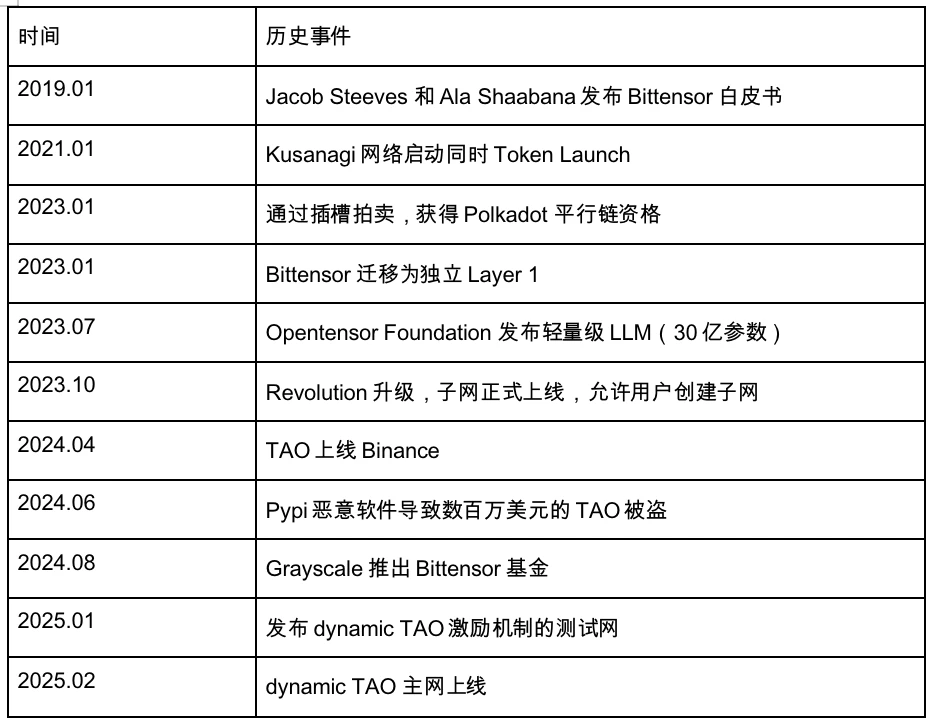
3.2 The Present
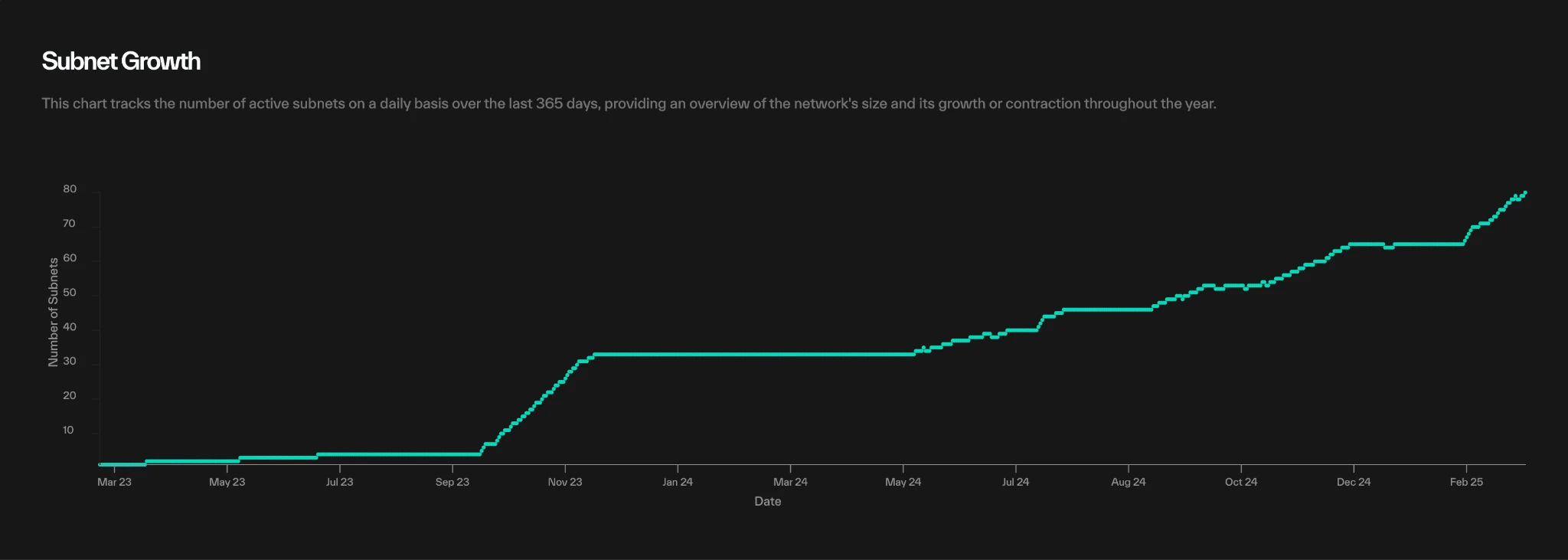
Subnet Growth, source: taostats
The subnets went live in October 2023, and after a year and a half of development, Bittensor currently has 80 subnets (including the Root subnet), and the ecosystem is showing a rapid growth trend. As of March 23, the total market capitalization of the ecosystem is 1.65 billion, and the 24-hour total trading volume of subnet tokens is 47.66 million.
3.2.2 Ecosystem Development
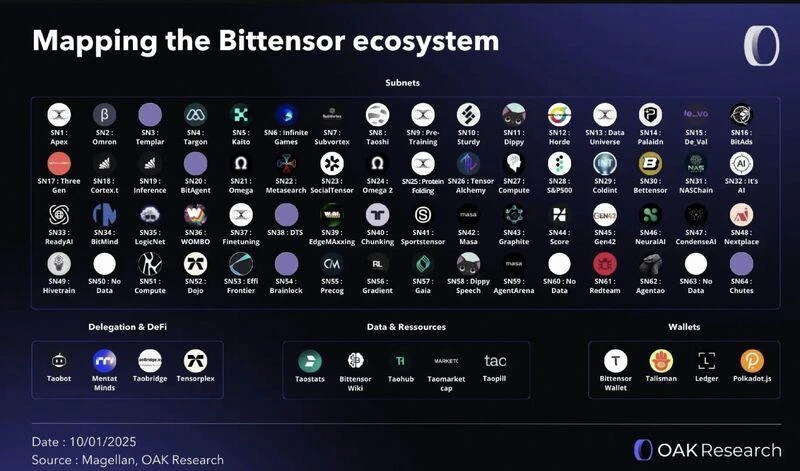
Bittensor ecosystem, source: OKA Research
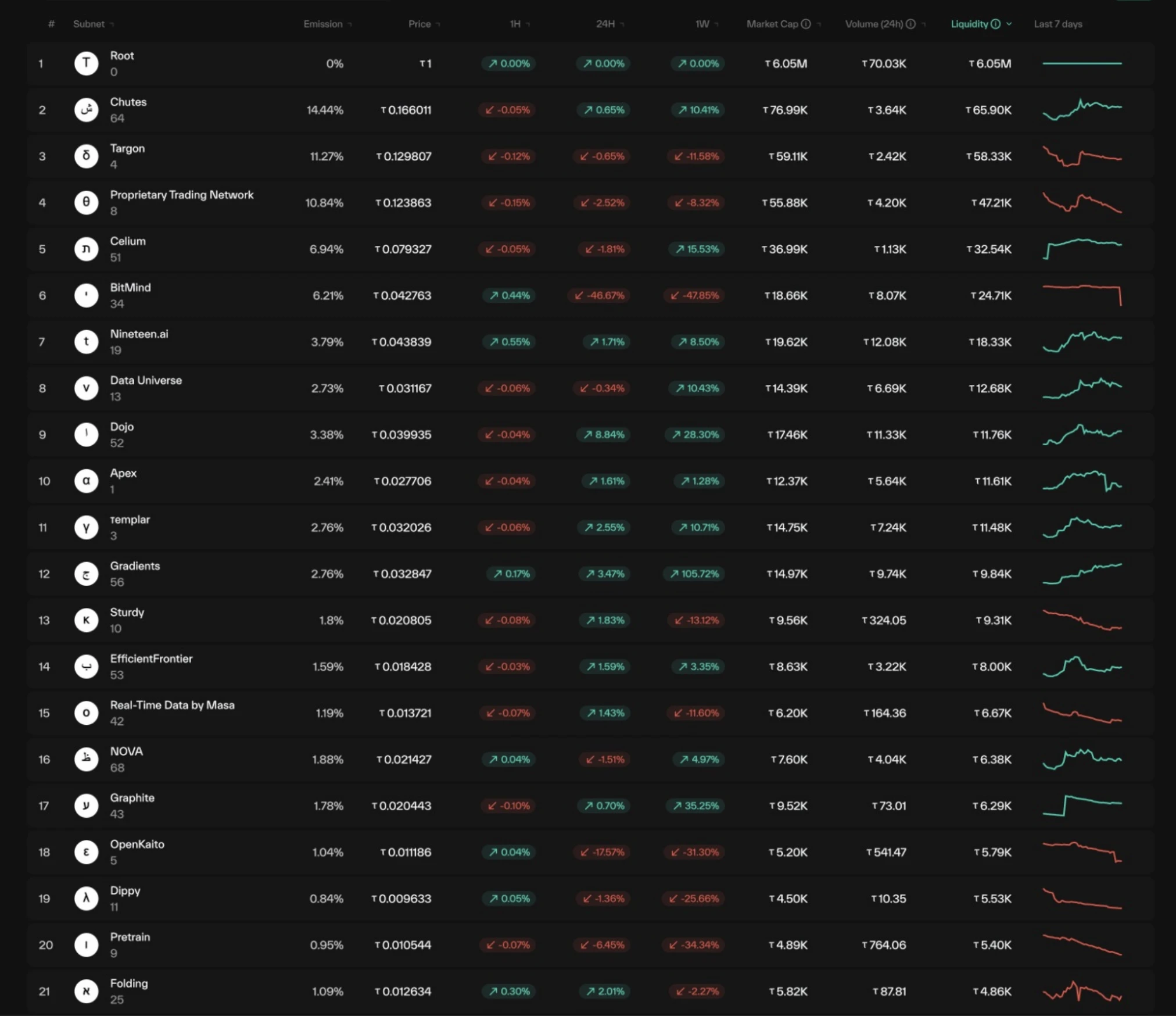
Top 20 rankings by Liquidity, source: Taostates
We have compiled the top 20 excluding the Root network (which was Bittensor's previous token distribution mechanism, relying on validators to determine contributions, and has now been abolished) ranked by liquidity in the AMM Pool. This reflects long-term value accumulation and recognition.
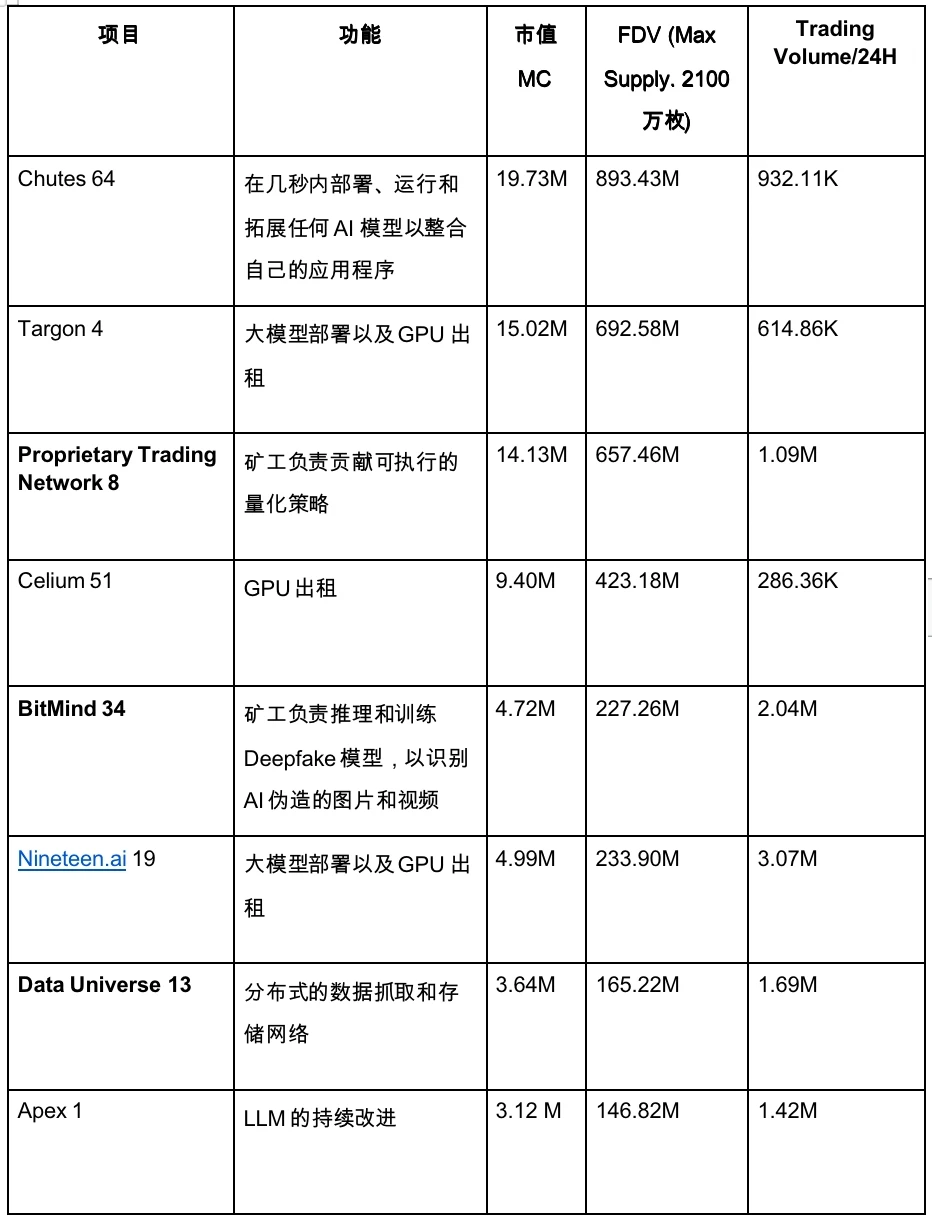
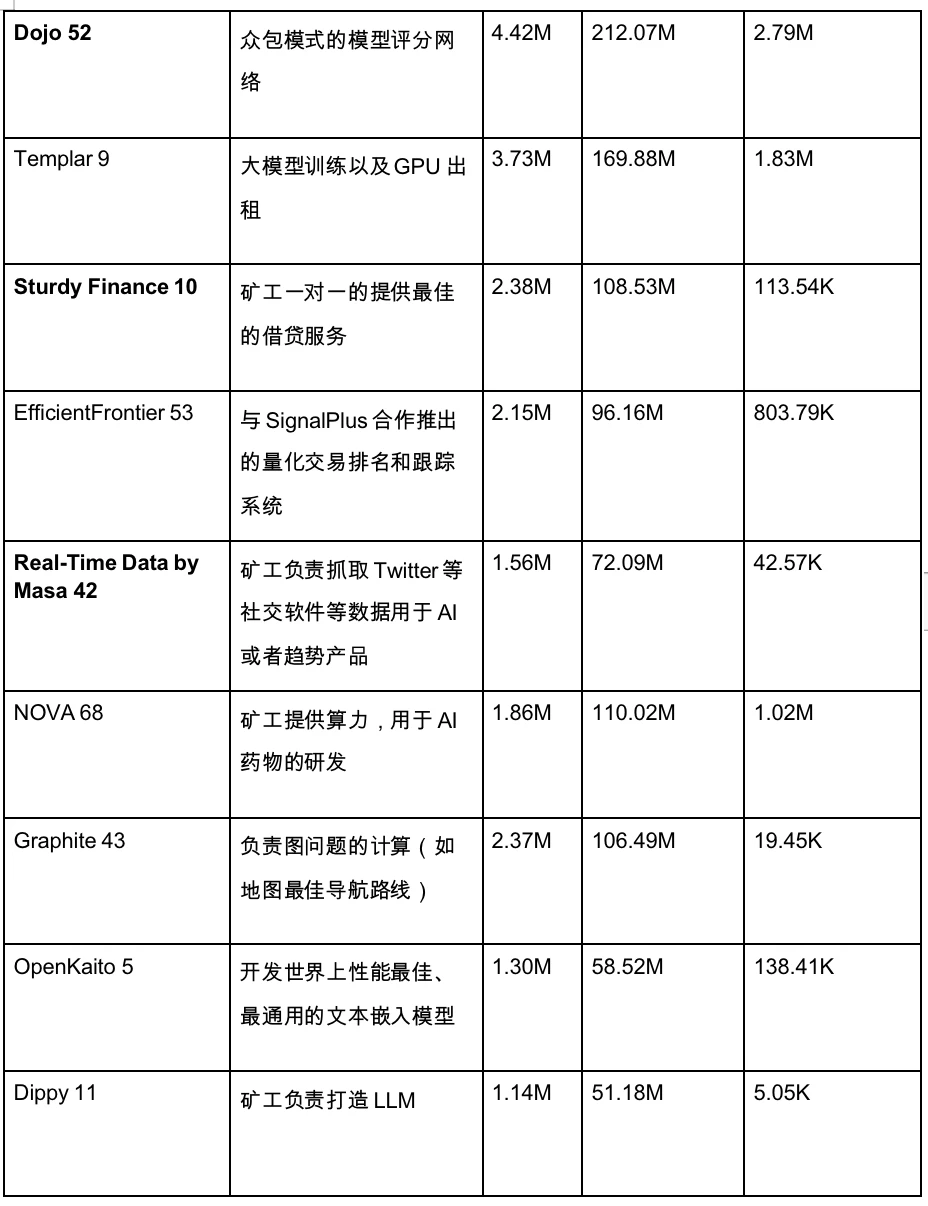

Bittensor's ecosystem has a high degree of redundancy. Among 20 projects, 11 utilize existing GPUs for pre-training, training, fine-tuning, and inference of large models. However, we can also see that subnets are using decentralized GPUs for computations involving proteins, graph theory, and large models. Notably, we found that many of the subnets in its ecosystem are developed by the same studio, such as Microcosmos (#1 #9 #13 #25 #37) and Rayon Labs (#64 #19 #Gradients), indicating a potential lack of sufficient independent developer teams in the ecosystem.
In terms of the real utility of the ecosystem, there are indeed some community voices that warrant reflection. For example:
Since the launch of the dynamic TAO mainnet, Bittensor has evolved into a decentralized universal incentive network. The formal offline of the Root subnet (losing centralized control) and the mechanism's reliance on the market capitalization of subnets can lead to some tokens, like MEME tokens, receiving incentives, thereby undermining the network's long-term vision.
Some LLM subnets focused on inference have brought inefficiencies and redundancy due to a large number of miners. At the same time, the incentive mechanisms and quality assessment levels of the subnets vary, leading miners to prefer using the same model to avoid misjudgment.
We believe that the first issue is indeed worth noting, and more mechanisms could be introduced to assess value or reintroduce a DAO organization to prevent actions that could harm the network. Regarding the second issue, we think it indicates that the owners of the subnet have not done their due diligence. If the subnet loses value, its price and incentives will gradually decrease, so this aspect can be adjusted by the market autonomously. From a long-term perspective, Bittensor's universal incentive network still holds significance, and in the ecosystem section, we will discuss its suitable application scenarios.
In terms of capital support, the Bittensor ecosystem is gradually expanding, and we have seen projects continuously receiving VC funding. For example:

3.2.2 Social Media

There is little connection between Bittensor and the community. Apart from Discord, there are no official community communication channels, and there is also a lack of market promotion activities.
3.3 Future
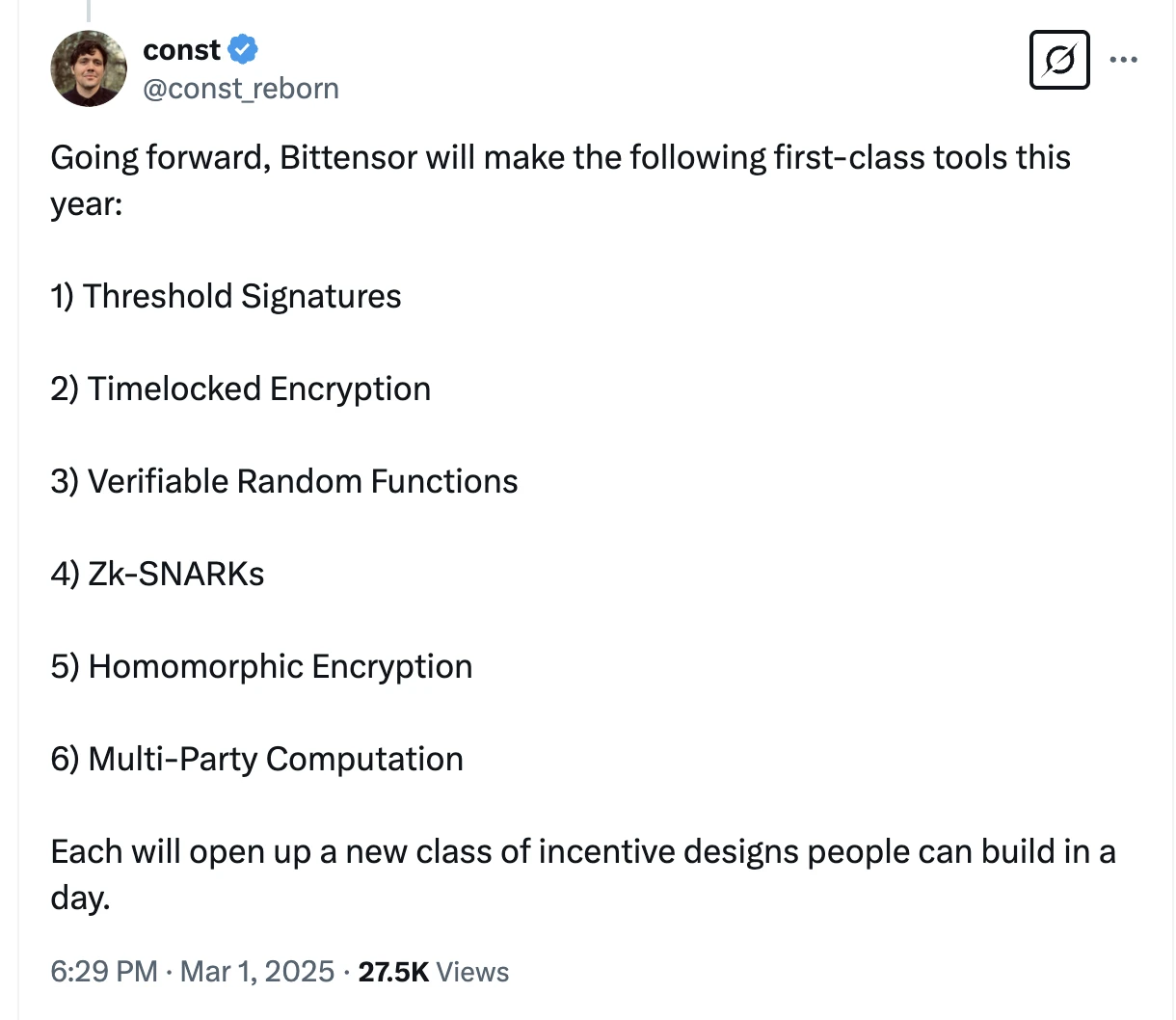
Team member X, source: const
The official blog stopped updating last year, and there is no official 2025 roadmap. The team's emphasis on developers far exceeds that on the community. The founder has roughly outlined the upcoming goals on X, including threshold signatures, time-lock encryption, verifiable functions, ZK-SNARKs, homomorphic encryption, and multi-party computation. These cryptographic tools are intended to help developers redesign the network incentive system.
4 Economic Model
4.1 Token Distribution

Vesting Schedule, source: Defillama
The Finney network launched on March 20, 2023, at which point the first batch of miners could go online to mine. Like Bitcoin, Bittensor has no first-market shares reserved for teams or VCs. The total token supply is 21 million, of which 36.95% (approximately 8.5 million) has been mined, leaving 68.05% to be mined. Each block mines one TAO, with a block time of 12 seconds, resulting in approximately 7,200 TAO mined per day, which, at a price of $250, amounts to about $1.8 million (with a daily spot trading volume of $96.62 million).

Staking Validators, source: Taostates
Currently, a total of 6,143,675 TAO has been staked (accounting for 72.3% of the circulating token supply), with an average annualized return rate for staking of about 15%-17%. In comparison, Solana's APR is 7.5%, NEAR's is 9.2%, and Ethereum's is 2.9%.
The token economics of TAO is completely aligned with BTC; the value of the entire network is the value of TAO. The token economics of TAO is entirely used for the distribution of network validators and subnet incentives, and full release will take hundreds of years, maintaining a stable and slow release pace for the entire network.
4.2 Token Uses
● Governance and Voting
● Registration Fees (for miners, validators, subnets)
● Recycling Mechanism: TAO has a unique recycling mechanism. The TAO network is a universal incentive network. The token recycling mechanism involves returning the rewarded TAO to the reward pool. The TAO recycled in the network mainly comes from two sources: registration fees from new miners and validators, and from subnets that have closed registration.
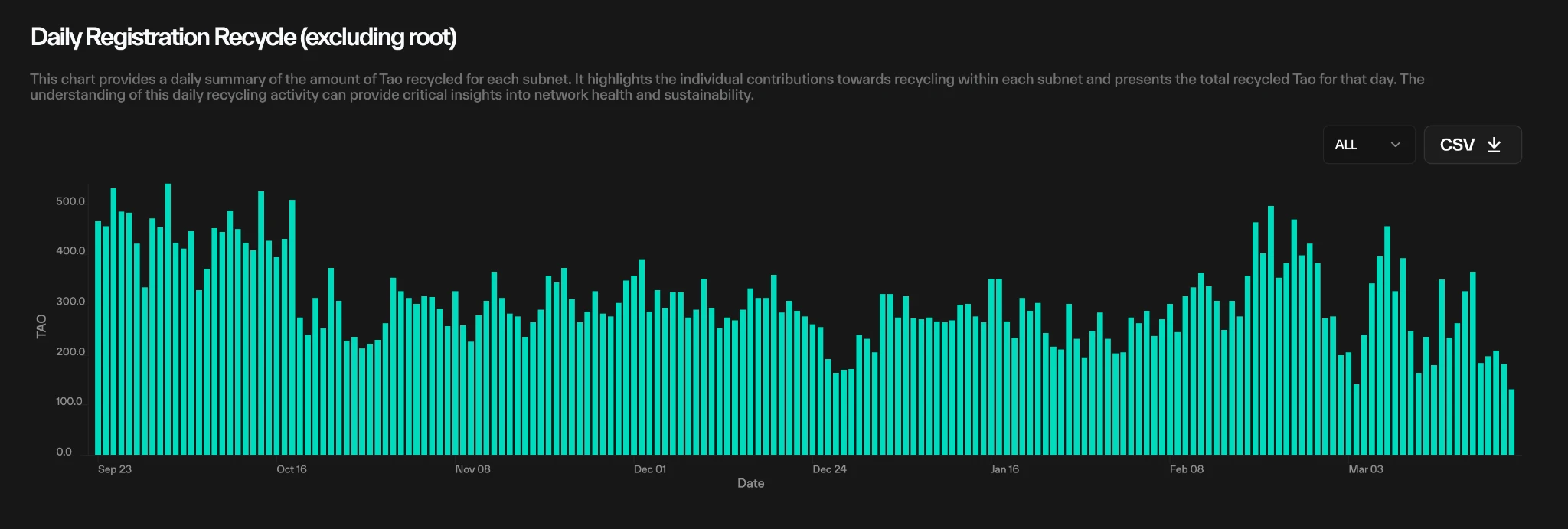
Registration Recycle, source: Taostates
The above chart shows the daily recycling situation. This recycling chart can partially reflect the level of attention to the ecosystem, with an average daily recycling of TAO between 150-300.
4.3 Holding Addresses
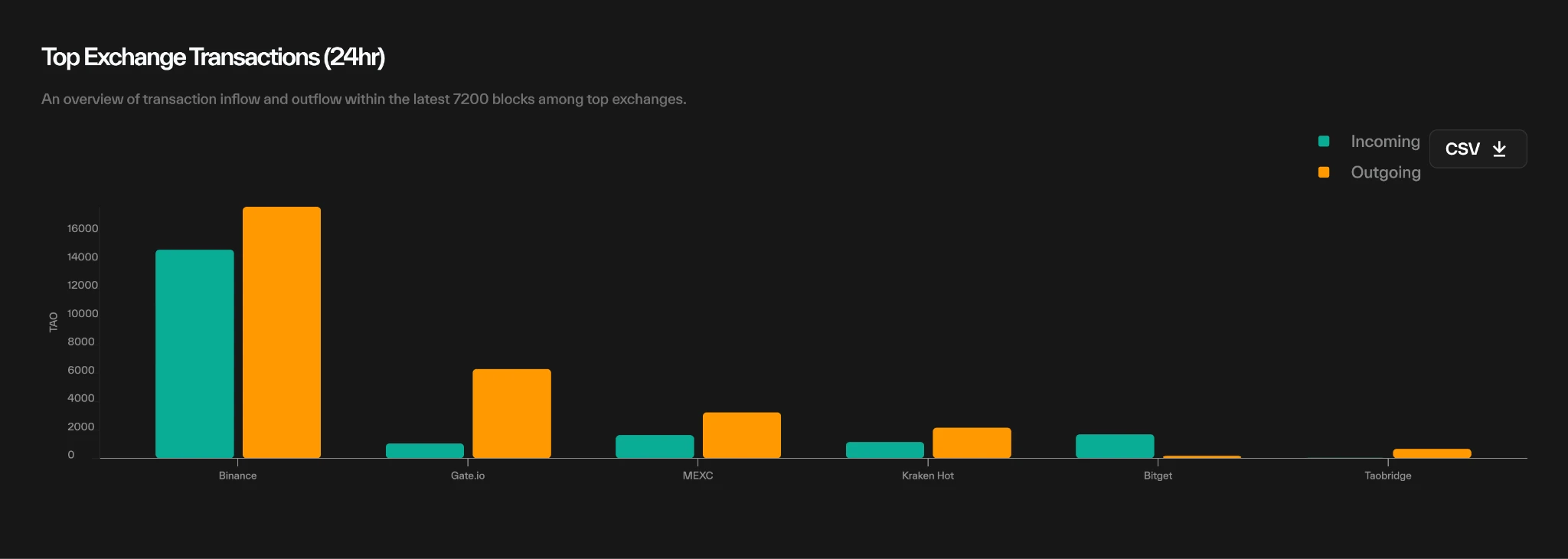
Exchange Transactions, source: Taostates
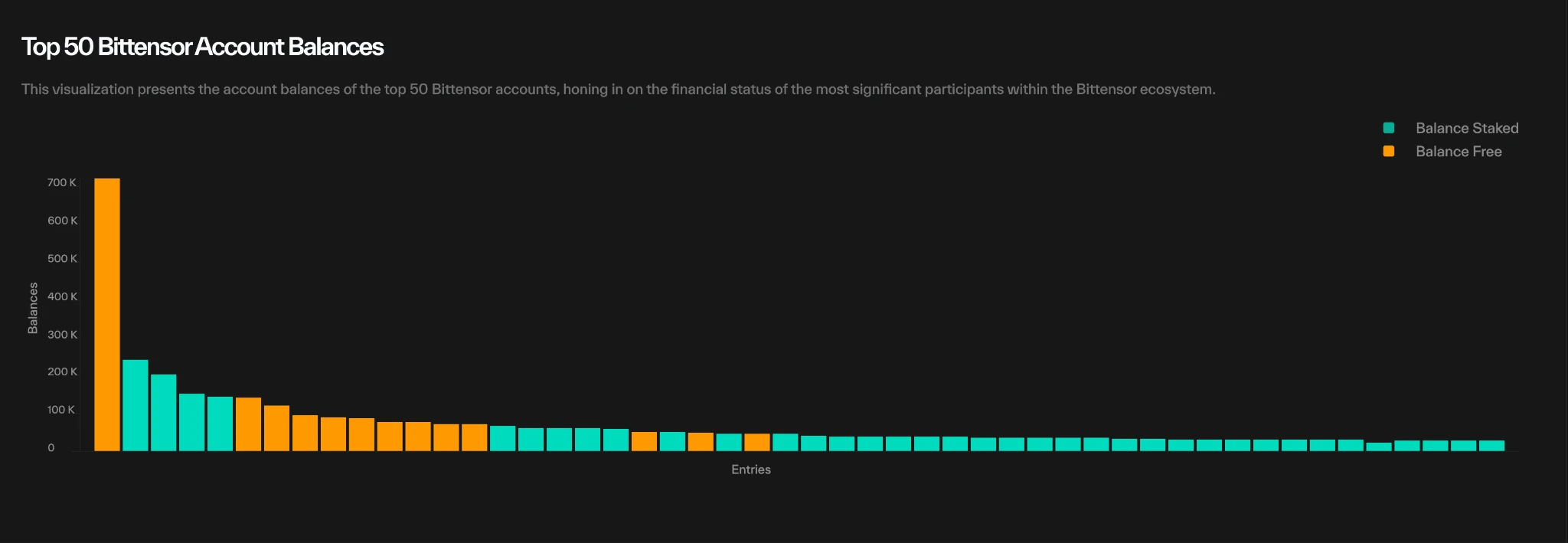
Top50 Balance, source: Taostates
The top 50 holding addresses account for about 30% of the circulating tokens, with Binance having the largest trading volume among exchanges, far exceeding the combined trading volume of other exchanges. The single verifiable holding address with the most tokens is MEXC.

TAO Trust, source: Grayscale
In terms of ETFs, Grayscale holds $5.5 million worth of TAO.
5 Market and Competition
Bittensor adopts a release mechanism similar to BTC, with no reservations at all. In terms of business, it employs game theory to construct competitive multi-task decentralized solutions, including a series of application scenarios such as the GPU market, scientific research, distributed data storage and indexing, and distributed AI training and inference. Allora, Sentient (mainly providing model inference), and Sahara AI (mainly providing crowdsourced data) are seen as competitors, but Sentient and Sahara AI are more like competitors of subnets, while Allora is regarded as the main competitor at the architectural level.
5.1 Market and Upstream/Downstream Overview
When discussing Bittensor's market and demand, we believe its business model is similar to crowdsourcing. There are similar examples in the Web2 world, such as Scale AI. Its business model involves hiring low-cost workers in Southeast Asia to label internet data for distribution to companies with data needs to train their large models in specific fields. The company's valuation has now exceeded $14 billion. The advantage of the crowdsourcing model compared to centralized operations is low cost and high flexibility, while centralized operations are more stable and standardized. The inherent drawback of decentralization is efficiency, which cannot be compared to centralization. Therefore, the contributions of Bittensor's subnets are mostly idle resources, but these resources are not without value; in fact, many idle resources have yet to fully realize their potential value. Meanwhile, some companies choose to outsource certain tasks to third parties to efficiently utilize resources and reasonably control costs in response to projects with high resource demands and short business cycles.
5.2 Project Introduction in the Field
Allora:
Allora is a self-improving AI network built by the community. Participants contribute to the network, and validators use context-aware reasoning techniques to assess the contributions of network participants. In the context of Allora, network participants include workers (providing specific resources, miners in Bittensor), assessors (evaluating work quality, validators from the now-defunct Root network in Bittensor), validators (responsible for instantiating most of the infrastructure of the Allora network through the Cosmos architecture), and consumers (developers with demand for the network's crowdsourced resources).
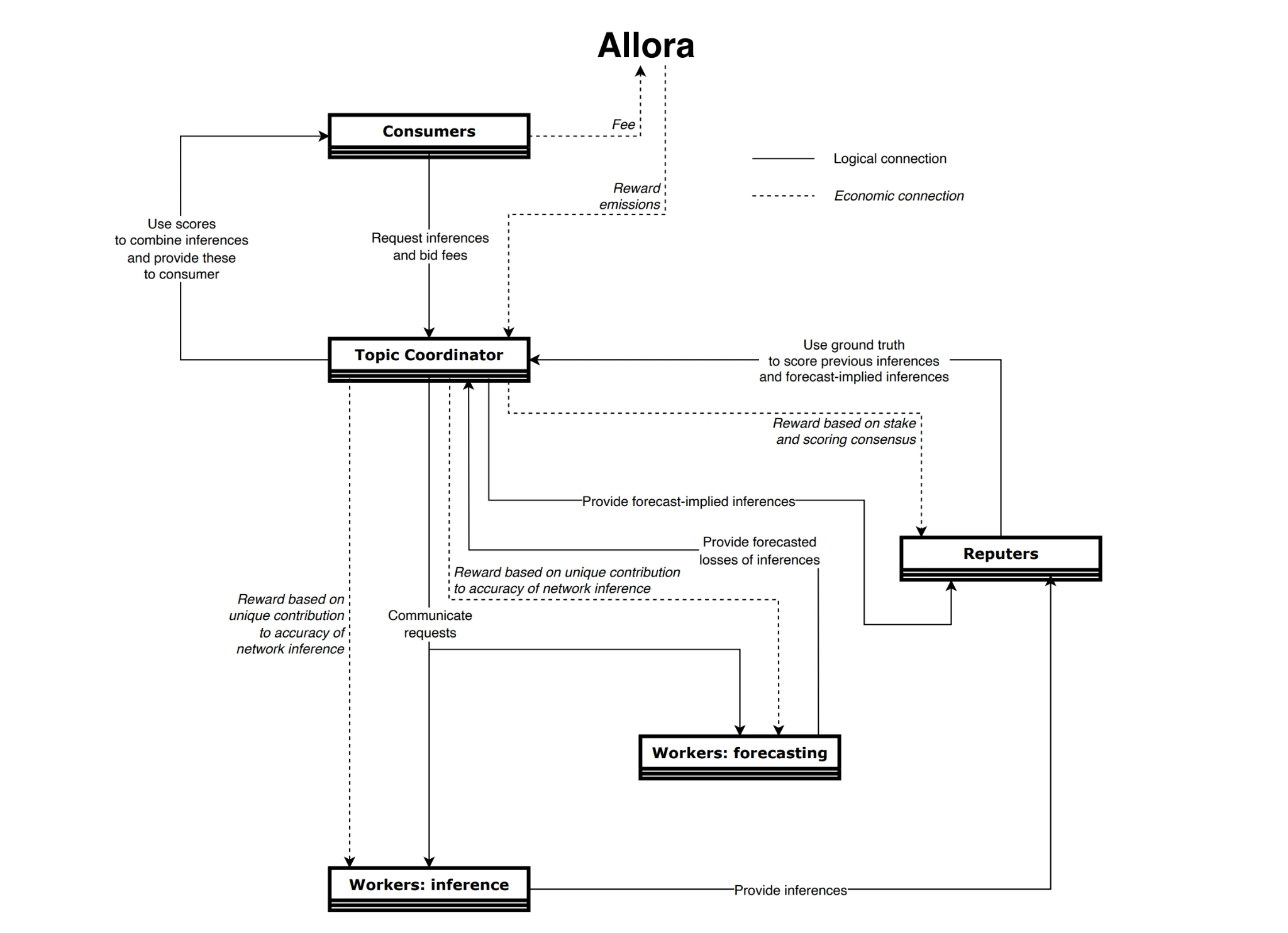
Allora Structure, source: Allora
In the Allora architecture, there are three main components handling Consumer requests: Workers: Inference is responsible for generating user requests, Workers: Forecasting evaluates the potential losses of inferences, and then Reputers combine the results of the two Workers to provide them to the Top Coordinator, who directly interacts with the Consumer.
The key point here is that the Workers: Forecasting component is a global component that can obtain results from the Inference Workers. For example, in a scenario predicting the price of a certain token, the Forecasting Worker learns from the final results and the current Inference Worker’s inferences that Worker A performs well in this scenario, while Worker B may be better suited for weather predictions. This is the context-aware technology emphasized in Allora's white paper, where the core of context-aware technology is the existence of the Forecasting Worker, which assesses the performance of Inference Workers in different scenarios.
5.3 Competitive Element Comparison
Allora and Bittensor essentially do the same thing, discovering the best Workers through game theory. However, the main differences are:
Miner Quality Assessment Method
Bittensor uses token economics to measure the amount of subsidies through a price discovery mechanism (subnet token prices). The main goal of the project is to increase the token price of the subnet, which allows for rewards from the issuance of subnet tokens.
Allora's assessment method employs the currently popular Shapley method—evaluating how much worse the network prediction would be without a Worker to assess the contribution of the Worker. After an event occurs, Reputers provide a fair loss that can be used for the next Forecasting Worker and can also assess the fairness of the Forecast Worker. Assuming one Worker is missing, according to a certain formula, the greater the loss becomes, the greater the contribution, and thus the more rewards.
There exists a ratio; for instance, one Worker may have a contribution of 10%, while another has 20%. They share a reward pool based on their contributions, and the Forecasting Worker, Reputer, and Validator also share this reward pool based on their contributions in the network, which comes from the issuance of each block.
Ecosystem Openness
Bittensor's ecosystem is significantly more open than Allora's. In the Bittensor ecosystem, subnet developers have a high degree of autonomy and can freely provide any services they wish while needing to find target customers themselves. In contrast, in the Allora ecosystem, the role of miners is clearly defined as providing large model services, which may focus on the financial sector or excel in predictive analysis. Additionally, the integration of the Allora ecosystem is usually collectively arranged by its organization. Thus, Allora resembles a self-adjusting large model cluster that provides real-time data, similar to Dubai Island, while Bittensor resembles multiple islands connected by bridges, with each island having its own currency and primary industry.
Community and Capital Support
Allora has a clear advantage in community building and capital support. Bittensor has not sought external financing, while Allora has secured nearly $33 million in funding, with leading investors including Framework Ventures, CoinFund, Blockchain Capital*, Polychain, and Archetype. Bittensor lacks any community and forum aside from Discord, while Allora has a well-rounded presence on TG, X, Discord, and forums. Overall, Bittensor's philosophy is more influenced by BTC, leaning towards community-driven initiatives.
Token Economics
Bittensor's subnets can issue their own tokens, but Allora's miners can only provide models and must use the same Allora token. Bittensor's token is a Fair Launch, while Allora has a significant amount reserved for teams and VCs. Both adopt Bitcoin's release model, halving every four years.
In summary, Bittensor's architecture is more unique, offering greater possibilities for an open ecosystem. However, the speed of ecosystem collaboration in Allora may surpass that of Bittensor, which requires independent developers for development, limiting the scale of its ecosystem. Strictly speaking, there are still no market competitors similar to Bittensor; its subnets operate as independent projects with mechanisms for self-issuing tokens, further highlighting the uniqueness and autonomy of its ecosystem.
6 Risks
Lack of infrastructure, insufficient marketing, and community support lead to high opacity.
High redundancy in the ecosystem, lacking external independent development teams, with one lab potentially building five or six subnet projects. This can lead to labs being unable to focus on a specific project, resulting in competition with independent similar projects.
The mechanism design of TAO is complex, involving multiple details, leading to high learning costs for retail investors and requiring a high level of knowledge from project parties.
References
"Bittensor (TAO): A comprehensive presentation of a protocol combining AI and blockchain": https://oakresearch.io/en/reports/protocols/bittensor-tao-presentation-protocol-combining-ai-blockchain
"Bittensor Docs": https://docs.bittensor.com/
"THUBA Research Report | Bittensor: When Will the Music Stop": https://foresightnews.pro/article/detail/67830
"Demystify Bittensor: How's the Decentralized AI Network?": https://www.trendx.tech/news/comprehensive-analysis-of-the-decentralized-ai-network-bittensor-1215435
"Reflexivity Research": https://x.com/reflexivityres/status/1843319486138474552
Disclaimer:
This content does not constitute any offer, solicitation, or advice. You should always seek independent professional advice before making any investment decisions. Please note that Gate.io and/or Gate Ventures may restrict or prohibit all or part of the services from restricted areas. Please read their applicable user agreement for more information.
About Gate Ventures
Gate Ventures is the venture capital arm of Gate.io, focusing on investments in decentralized infrastructure, ecosystems, and applications that will reshape the world in the Web 3.0 era. Gate Ventures collaborates with global industry leaders to empower teams and startups with innovative thinking and capabilities to redefine the interactions between society and finance.
Official website: https://ventures.gate.io/
Twitter: https://x.com/gate_ventures
Medium: https://medium.com/gate_ventures
免责声明:本文章仅代表作者个人观点,不代表本平台的立场和观点。本文章仅供信息分享,不构成对任何人的任何投资建议。用户与作者之间的任何争议,与本平台无关。如网页中刊载的文章或图片涉及侵权,请提供相关的权利证明和身份证明发送邮件到support@aicoin.com,本平台相关工作人员将会进行核查。




